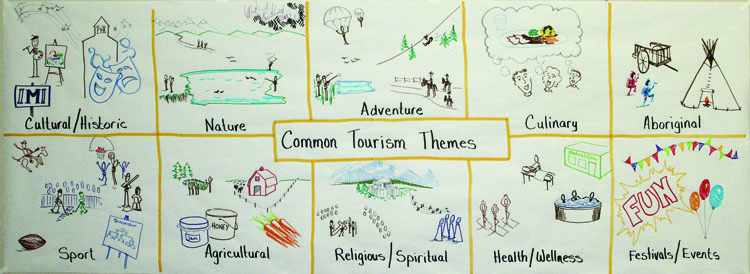Current Temperature
-15.7°C
Canada’s Mormon Trail begins defining unique tourism niche
Posted on January 22, 2015 by Westwind Weekly
By Karlene Skretting
reporter.karlene@gmail.com
Westwind Weekly News
Over 40 members from the communities of Magrath, Raymond, Cardston and Stirling came together on Jan. 14 at the Magrath Senior’s Centre to undertake a full day of tourism visioning and planning for Canada’s Mormon Trail.
“The fact that so many people in the community were willing to give of their time, proves that they realize the importance of these visioning exercises and can see how the Mormon Trail will enhance our local tourism,” said Brenda Beck, chair of the Mormon Trail Committee
The multi-municipal project had representatives from respective town councils, municipal staff, historical societies, tourism operations and attractions, chambers of commerce, service groups, community events, and community residents.
A wide range of opinions were shared and discussed.
With funding through the provincial Regional Collaboration Program, a portion of the $45,000 grant that the Mormon Trail Committee received in July, was used to hire Darlis Collinge from Down to Business Solutions to facilitate the day and Positive Culture to graphically capture the workshop outcomes.
Darlis set the stage and provided information on the tourism industry in Alberta. Tourism is the third largest industry behind oil and gas and agriculture. Globally it is a multi-billion dollar industry.
“We think of a ‘tourist’ as someone who researches and plans a multi-visit to a location,” said Collinge, “but most often, they are our neighbours from other parts of Southern Alberta and typically are family and friends here for a visit or to enjoy what you have to see, do or experience.”
She introduced the concept of using the term ‘visitors’ rather than ‘tourists’ to help people recognize the importance of ensuring that every visitor’s experience in the community is positive.
Through the course of the day, participants made contributions to the four communities involved in The Mormon Trail and identified existing tourism assets.
Discussion went on to confirm the tourism theme of The Mormon Trail as Cultural / Historic.
Collinge noted that by having a clearly defined theme, it is easier for a region to position themselves in the tourism industry and for communities to develop and market their attractions, and for visitors to know what to expect when they visit.
“There is a lot of history in the different communities that isn’t noticeable when you first come in,” said Beck.
In an interview after the tourism visioning and planning session, she added that Stirling’s primary focus would be on the fact that they are one of only three historic communities in Canada, while Cardston will draw from the fact that it is home to Canada’s first LDS Temple. Magrath will be focusing on the history of water and irrigation in the area, while Raymond opted to position themselves as the home of Canada’s first outdoor rodeo.
Collinge explained that, “niches allow each community to have their own tourism identity while working together to support the overall regional theme, therefore garnering more tourism attention both individually and collectively.”
It terms of who is most likely to visit the region, the Explorer Quotient (EQ), which was developed by the Canadian Tourism Commission and is used across the country to assist with developing targeted marketing campaigns and creating new tourism products, said that advertising should be targeted at ‘Learners’ and ‘Familiarity Seekers’.
‘Learners’ want to know what it is like to be part of a community, they are looking to try an activity that the pioneers would have done to better understand the area, explained Beck. While Familiarity Seekers are the people who are most likely to stay close to home, not spend a bunch of money, but still want an activity to do with family or friends.
“If you think about Magrath Days for example, basically the size of our Town doubles that weekend. If we could tie some visitor experiences in along with that, then we have a lot of people who are already interested in the history and culture in the area,” said Beck.
Taking advantage of existing events and incorporating The Mormon Trail over time is a focus going forward.
The Mormon Trail Committee still has a lot of work ahead to develop the trail and guide tourism forward, but one of the biggest challenges going forward is defining what exactly the term “The Mormon Trail” refers to.
“It is an inclusive visitor experience that we are after that incudes all different cultures. We have a really interesting story to share … The more I look into the history of the area, the more interesting it becomes for me,” shared Beck.
Beck noted that the most important thing for people to realize is that the trail doesn’t just look at the Mormonism of the communities, “it is only a small piece,” of the culture and history in the area.
Ensuring that locals understand that is a big priority, so that when visitors come enjoy the trail, discussions reflect that and correct information is spread.
The information that was gathered at the workshop will be used to develop a Tourism Vision for The Mormon Trail communities and identify the next steps for tourism development. In the next few weeks, a Community Tourism Awareness Campaign training session will be held as part of this project.
Residents are invited to complete the online tourism survey prior to Feb. 6. For more information on the Awareness training or how to access the online survey, please contact your local municipal office representative on The Mormon Trail Committee: Wade Alston (Magrath), Kurtis Pratt (Raymond), Mike Selk (Stirling), or Jeff Shaw (Cardston).
Leave a Reply
You must be logged in to post a comment.

